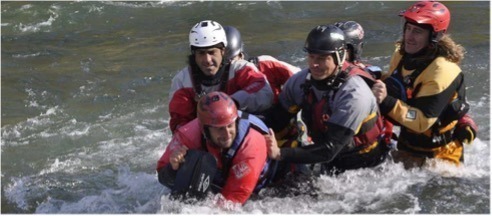 It’s rare that I write a personal article but lockdown has given me plenty of time so as I while away the hours and days, I’ve found myself reviewing the last few months and in particular being assessed for the New Zealand raft guide qualification. During lockdown I’m living at the rafting centre where I’ve spent the summer (southern hemisphere) as I’ve been unable to leave due to flight cancellations and then the country going into lockdown. I’m living with a fellow trainee to the NZ qualification so we’ve spent a fair bit of time cleaning, tidying, and then playing with rafts and kit – albeit missing the almighty white water that we’re craving! So we’ve ended up picking up ropes and setting each other challenges to pass the time.
It’s rare that I write a personal article but lockdown has given me plenty of time so as I while away the hours and days, I’ve found myself reviewing the last few months and in particular being assessed for the New Zealand raft guide qualification. During lockdown I’m living at the rafting centre where I’ve spent the summer (southern hemisphere) as I’ve been unable to leave due to flight cancellations and then the country going into lockdown. I’m living with a fellow trainee to the NZ qualification so we’ve spent a fair bit of time cleaning, tidying, and then playing with rafts and kit – albeit missing the almighty white water that we’re craving! So we’ve ended up picking up ropes and setting each other challenges to pass the time.
It got me thinking about how much I struggled with knots when I first got to NZ. I’ll be honest – I was hopeless. I’d barely done anything more than an Italian hitch, figure of eight on a bite and a no-knot for the last three years. I’m fairly certain Tim was facepalming himself when he saw me pick up a rope.
So having relearnt all the knots I’d forgotten and a couple new ones, I find myself passing the time in lockdown watching videos of rafting, and in particular raft carnage. It’s got me wondering how some of the situations could have been handled differently. So I reached out to a few industry friends around the globe and asked them to recall a situation they’ve found themselves in where a knot has either failed or a knot has been the saving grace:
Rafael Gallo, Rios Tropicales, Honorary IRF President:
Knots must be practiced, practiced, practiced, when you are waiting for your guests to arrive at the river, practice, challenge your team mates, with a knot session! The more you practice the easier will be for you to decide what knot you need, and best how to untie, please practice, practice, practice!
Ine Skjørten Wilson, Planet River:
I’ve had very few “wow that was close” experiences on the river. However, going back to I think spring 1992, California, Moss Canyon, I was standing safety on river right, and what i can remember is that it was crucial that no one ended up swimming the next down stream rapid. Here I am with one throw bag, I remember looking hard for a possible anchor point… no trees…. one piece of rock sticking out from the ground…. and shit!! Three swimmers coming out of the upstream rapid, and I remember very clearly the next few moments… timing of the throw….. where to hit as to get all three to reach the rope….. knowing at the same time that three might be a bit much to hold so at the same time get a no knot around the rock sticking out from the ground…. all in one go and next my big relief the moment the rope swung toward the eddy and one of the three hanging on could let go and swim to shore to ease the weight on the noknot and my “holy smoke that was close” moment. The intensity of the moment, the images still in my head and the now or never feeling is very clear.
Tim Marshall, Ultimate Descents NZ:
Slippy hitch AKA the releasable clove hitch. This is a very versatile hitch/knot I use for most things. Tieing up my raft. just add a couple of half hitches over the main line to secure for the night. Transporting rope across river, towing cars out of the ditch! Must always pull tight before use to make sure the hitch has caught itself, so it won’t self release. Easy to undo!
Paul Eames, Awastone / Mangaweka Adventure Company:
Knots don’t fail unless the wrong knot has been selected for the purpose, the reason we need a good quiver. The best example i can think of is using a bowline to connect two ropes together when lining rafts down rapids, often results in someone swimming to get the raft!
Mihai Mares, Mares Outdoor Events:
Good knots looks nice, but not every nice looking knot works good. Master a handful of knots, then use your imagination and they will pull you out of most troubled times!
Mark Hirst, Lapin Koskikoulu, IRF GTE Secretary:
I wanted to share an experience about when a correctly tied Prusik knot worked for me. I was working as a safety kayaker on the Upper Seti river in Nepal. I noticed that one of our rafts had become well & truly pinned on a rock. When I eventually climbed out of my kayak to help the other guides I noticed that none of them were carrying a prusik loop. I quickly took one of the prusik loops from my PFD and handed it over to the boys who then struggled to correctly tie a triple wrap prusik under pressure. I quickly jumped in & helped out build a system to retrieve the pinned raft.
The moral of the story when we got back to base was:
-
- Practice your knots
- Carry the right equipment
- Get access to the correct training
#RaftersAreAwesome #raftguide #StrongerTogether #RiverFamily #WeAreIRF









